THE KITE RUNNER Arizona Theatre Company Play Guide 1
THE KITE RUNNER Arizona Theatre Company Play Guide 1
THE KITE RUNNER Arizona Theatre Company Play Guide 1
You also want an ePaper? Increase the reach of your titles
YUMPU automatically turns print PDFs into web optimized ePapers that Google loves.
<strong>THE</strong> <strong>KITE</strong> <strong>RUNNER</strong><br />
ROSTAM AND SOHRAB<br />
Sharif recalls the glory days of kite flying in Kabul, before the Taliban. "Before the Taliban,<br />
people used to fly kites in a place called Chaman-i-Babrak [in northern Kabul], and kite<br />
flying competitions were held there. Kids, young people, and older people from all over<br />
Afghanistan and Kabul City would gather there. They used to lay wagers on fighting kites."<br />
Sharif smiles. He wants to get back to his kite flying. There is a battle to be won.<br />
- from http://www.rferl.org/content/article/1101400.html (from The Kite Runner: A Study <strong>Guide</strong> reprinted with<br />
permission from San Jose Repertory <strong>Theatre</strong>)<br />
ROSTAM AND SOHRAB<br />
The great Rostam was unaware that he had a son, Sohrab,<br />
by the princess Tahmineh. After years without any real<br />
knowledge of one another, Rostam and Sohrab faced each<br />
other in battle, fighting on opposing sides. Never having<br />
met each other face to face, Sohrab had suspicions that the<br />
man he fought may be his father. The truth was kept from<br />
father and son and, in order to protect himself, Rostam<br />
continually denied his identity to Sohrab.<br />
They fought in single combat and Rostam wrestled Sohrab<br />
to the ground, stabbing him fatally. As he lay dying, Sohrab<br />
recalled how his love for his father—the mighty Rostam—<br />
was what brought him<br />
there in the first place.<br />
Rostam, to his horror,<br />
The story of Rostam and<br />
Sohrab is one of the most<br />
famous tales from the Iranian<br />
epic The Shanameh, an epic<br />
poem written by Ferdowsi<br />
around 1000 CE. The poem is<br />
a masterpiece of the Persian<br />
language, and a source of great<br />
national pride for Iranians. The<br />
tale of Rostam and Sohrab is the<br />
favorite story of Hassan, Amir’s<br />
friend and his servant’s son.<br />
realized the truth. He saw his own jewel on the arm of<br />
Sohrab, which he had given to Tahmineh many years<br />
before and which Tahmineh had given to Sohrab before<br />
the battle, in the hope that it might protect him. But he<br />
realized the truth too late:<br />
“I that am old have killed my son. I that am strong have<br />
uprooted this mighty boy. I have torn the heart of my<br />
child, I have laid low the head of a Pehliva...My heart<br />
is sick unto death.”<br />
-from The Kite Runner: A Study <strong>Guide</strong> reprinted with permission from San Jose Repertory <strong>Theatre</strong><br />
Artist’s rendering of the story of Rostam and Sohrab<br />
<strong>Arizona</strong> <strong>Theatre</strong> <strong>Company</strong> <strong>Play</strong> <strong>Guide</strong> 25







![Play Guide [356k PDF] - Arizona Theatre Company](https://img.yumpu.com/46218320/1/190x245/play-guide-356k-pdf-arizona-theatre-company.jpg?quality=85)
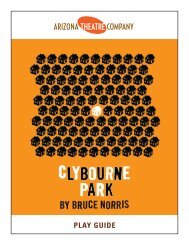
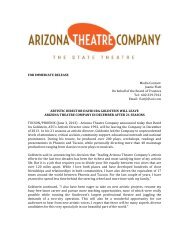
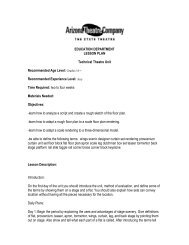

![[title of show] Arizona Theatre Company Play Guide 1](https://img.yumpu.com/24482689/1/190x245/title-of-show-arizona-theatre-company-play-guide-1.jpg?quality=85)
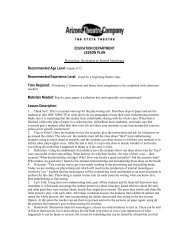
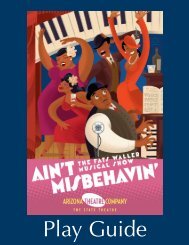
![Play Guide [1.2MB PDF] - Arizona Theatre Company](https://img.yumpu.com/11952176/1/190x245/play-guide-12mb-pdf-arizona-theatre-company.jpg?quality=85)
